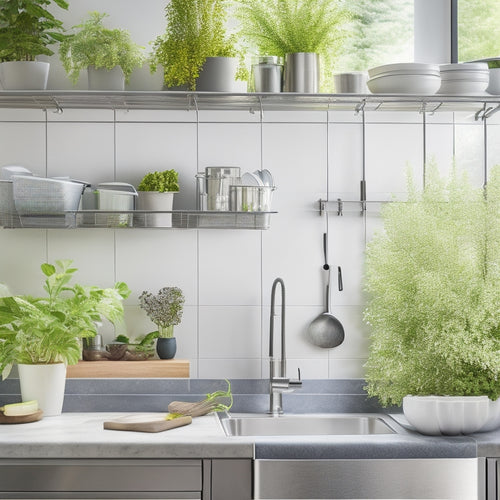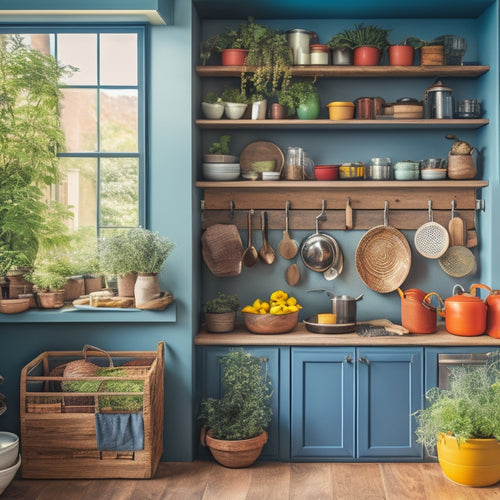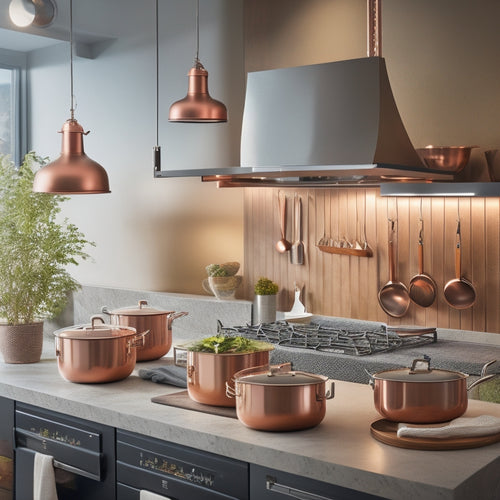
Kitchen Cabinet Organization Essentials: Shelf by Shelf
Share
You're about to transform your kitchen cabinets into a well-oiled machine, where every item has its designated place and purpose. Start by evaluating your cabinet needs, prioritizing organizational goals, and removing everything from your cabinets. Categorize items into must-haves, nice-to-haves, and occasional-use items, and allocate space for essentials. Optimize shelf height and depth by measuring internal cabinet dimensions and item sizes, and utilize corner cabinet solutions for maximum storage. Finally, maximize vertical storage space by placing shelves, hooks, and baskets strategically. Now, you're ready to customize your shelves from top to bottom, and discover the secrets to maintaining your newly organized kitchen.
Key Takeaways
• Assess your current kitchen cabinet layout and contents to prioritize organizational goals and ideal functional layout.
• Allocate space by categorizing items into must-haves, nice-to-haves, and occasional-use items, and utilize vertical space with shelves and hooks.
• Optimize shelf height and depth by measuring internal cabinet dimensions and item sizes, and install adjustable shelving for customization.
• Utilize corner cabinet solutions, such as Lazy Susans, pull-out drawers, and tiered shelving, to maximize vertical space and accessibility.
• Maximize vertical storage space by placing shelves, hooks, and baskets strategically, and using vertical dividers to separate and organize items.
Assessing Your Kitchen Cabinet Needs
Take stock of your kitchen's current cabinet layout and contents to identify areas that need improvement and prioritize your organizational goals. This pivotal step will help you determine what you need to achieve a more functional and efficient kitchen.
Begin the decluttering process by removing everything from your cabinets and sorting items into categories. This will give you a clear picture of what you have and what you can get rid of. Consider the items you use frequently and those that are seasonal or occasional. Store items you want to keep in storage containers, labeling them for easy identification.
Next, envision your ideal functional layout. Think about the workflow in your kitchen and where you'd like items to be placed for easy access. Identify the items you use most frequently and plan to store them in accessible locations. Consider the height and depth of your cabinets and how you can maximize storage while maintaining a clutter-free environment.
Allocating Space for Essentials
With a clear understanding of your kitchen's unique needs, you can now allocate space for essentials by categorizing items into must-haves, nice-to-haves, and occasional-use items. This will help you prioritize what goes where, ensuring that your most frequently used items are easily accessible.
To maximize your cabinet space, consider the following strategies:
-
Container organization: Use bins, baskets, and containers to store dry goods, snacks, and spices. Label each container so you can quickly identify what's inside.
-
Utilize vertical space: Install shelves, hooks, or a pegboard to hang items like utensils, pots, and pans, freeing up floor and counter space.
-
Divide and conquer: Implement a labeling system and use drawer dividers, utensil caddies, and adjustable shelves to create separate zones for different types of items.
Optimizing Shelf Height and Depth
By evaluating your cabinet's internal dimensions and the sizes of your kitchen essentials, you can optimize shelf height and depth to create a customized storage system that fits your needs. Start by measuring the internal width, height, and depth of your cabinet, as well as the sizes of the items you plan to store. This will help you determine the ideal shelf height and depth for each shelf.
Consider installing adjustable shelving to accommodate items of varying sizes. This will allow you to customize the shelf height and depth as needed, ensuring that each item has a designated spot. Adjustable shelving also enables you to reconfigure your storage system as your kitchen essentials change over time.
To achieve custom organization, categorize your kitchen essentials into groups, such as baking supplies, cooking utensils, and dinnerware. Then, assign a specific shelf or section to each group, taking into account the frequency of use and the items' sizes.
Utilizing Corner Cabinet Solutions
You'll find that corner cabinets, often the most challenging spaces to organize, can be transformed into highly functional storage areas with the right solutions. By incorporating clever design elements, you can turn these previously wasted spaces into efficient storage zones.
Here are three ways to optimize your corner cabinets:
-
Lazy Susan: A Lazy Susan is a rotating shelf that allows you to easily access items in the back of the cabinet. This is especially useful for corner cabinets, where it can be difficult to reach items without having to dig through everything in front of them.
-
Pull-out drawers: Installing pull-out drawers in your corner cabinets can provide easy access to items, making it simple to find what you need without having to rummage through the entire cabinet.
-
Tiered shelving: Tiered shelving allows you to maximize the vertical space in your corner cabinets, making it easy to store a variety of items, from cooking utensils to dinnerware.
Maximizing Vertical Storage Space
Take advantage of your kitchen's often-wasted vertical space by strategically placing shelves, hooks, and baskets to store items that are less frequently used. This will help keep your countertops and lower shelves clutter-free, making it easier to access the items you use daily.
Install shelves that go up to the ceiling to maximize storage for infrequently used items like special occasion dishes, cookbooks, or large serving platters. Consider using a vertical divider to separate items and keep them organized.
You can also utilize the back of a cabinet door by attaching hanging hooks for items like oven mitts, tea towels, or even a spice rack.
In addition, install baskets or bins on high shelves to store snacks, baking supplies, or cleaning products. Label each basket or bin so you can easily find what you need.
Implementing a Maintenance Routine
Establish a regular cleaning schedule to maintain your newly organized kitchen cabinets, ensuring that everything remains in its designated place and clutter doesn't build up over time. This will help you stay on top of your kitchen organization and keep your space feeling calm and functional.
To make maintenance a breeze, consider the following strategies:
-
Set aside time each week to quickly tidy up your cabinets and countertops, putting away items that are out of place and wiping down surfaces.
-
Keep essential cleaning supplies on hand, such as all-purpose cleaners, disinfectants, and dusters, so you're always prepared to tackle messes as they arise.
-
Practice regular decluttering and organizing, going through your cabinets and pantry every few months to get rid of expired or unused items and reorganize your storage systems as needed.
Frequently Asked Questions
How Do I Prevent My Cabinet Shelves From Sagging Under Heavy Loads?
To prevent sagging, you'll want to reinforce your shelves with added support, distributing weight evenly, and utilize adjustable dividers and storage bins to keep items organized and prevent overload.
Can I Use Adhesive Hooks on My Cabinet Doors for Hanging Items?
You can use adhesive hooks on your cabinet doors for hanging items like pots, pans, and utensils, but verify the hooks are rated for the weight and won't damage the door's finish.
Are There Any Eco-Friendly Kitchen Cabinet Organization Materials Available?
You're likely aware that 75% of waste is generated during food production and processing, so it's great you're considering eco-friendly options! Look for bamboo organizers and recycled plastic bins, which offer sustainable solutions for your kitchen cabinet organization needs.
How Often Should I Clean My Kitchen Cabinet Shelves and Contents?
You should establish a regular cleaning schedule to maintain your shelf organization, ideally every 1-2 months, to prevent dust accumulation and guarantee item rotation, keeping your kitchen cabinets tidy and organized.
Can I Customize My Cabinet Organization System to Fit My Unique Needs?
"You're in luck! You can totally customize your cabinet organization system to fit your unique needs. Explore various customization options to optimize your space, ensuring a seamless workflow that suits your serving style and priorities."
Related Posts
-

Wall-Mounted Dish Drainer Racks for Kitchens
Wall-mounted dish drainer racks are a game changer for your kitchen. They maximize vertical space, freeing up preciou...
-

Over-The-Door Kitchen Rack Installation Tips
To install an over-the-door kitchen rack effectively, start by measuring your door's clearance to guarantee a proper ...
-

Ceiling-Mounted Pot Racks for Professional Chefs
Ceiling-mounted pot racks are revolutionary for professional chefs like you. They make use of vertical space, keeping...


